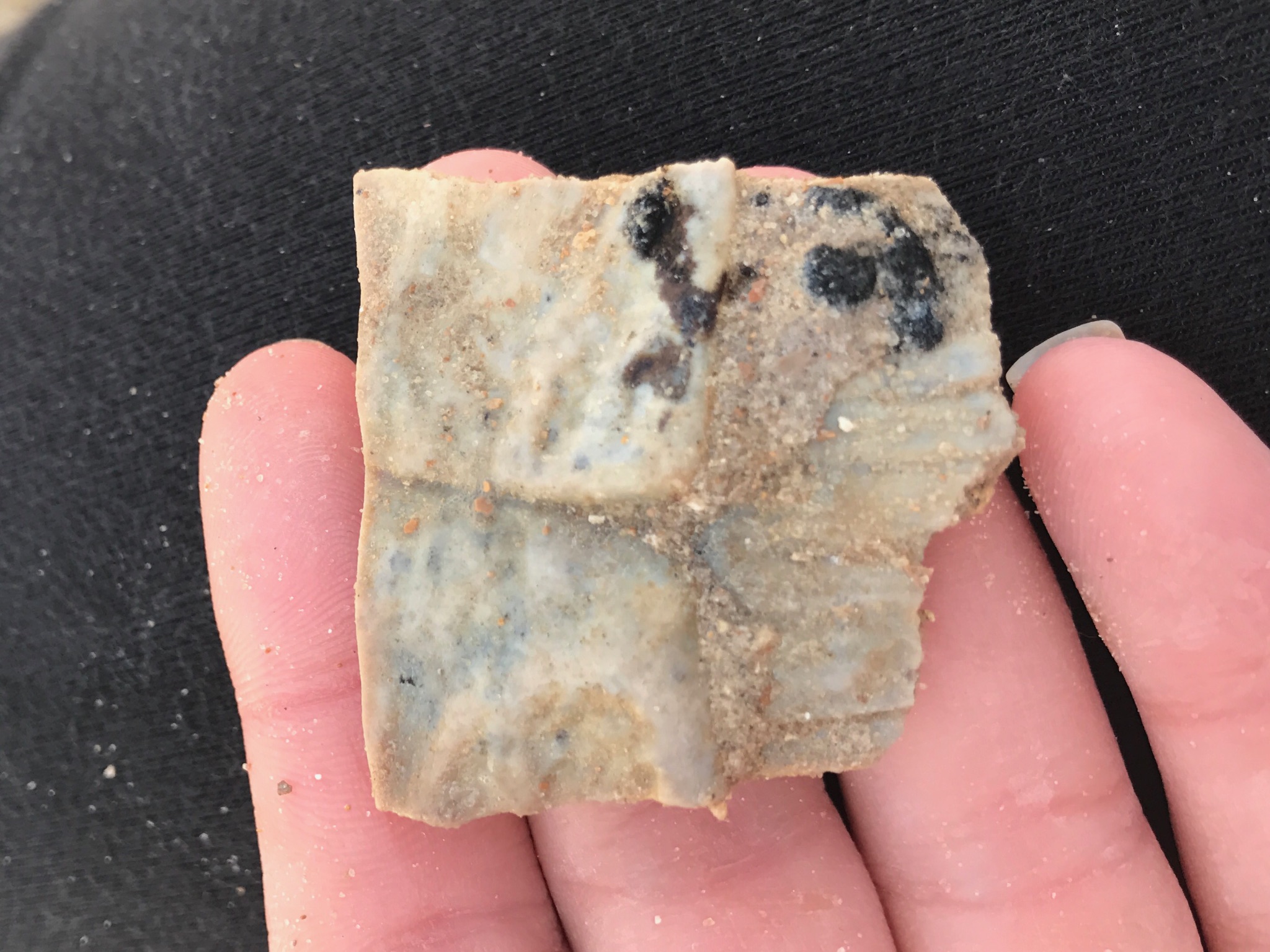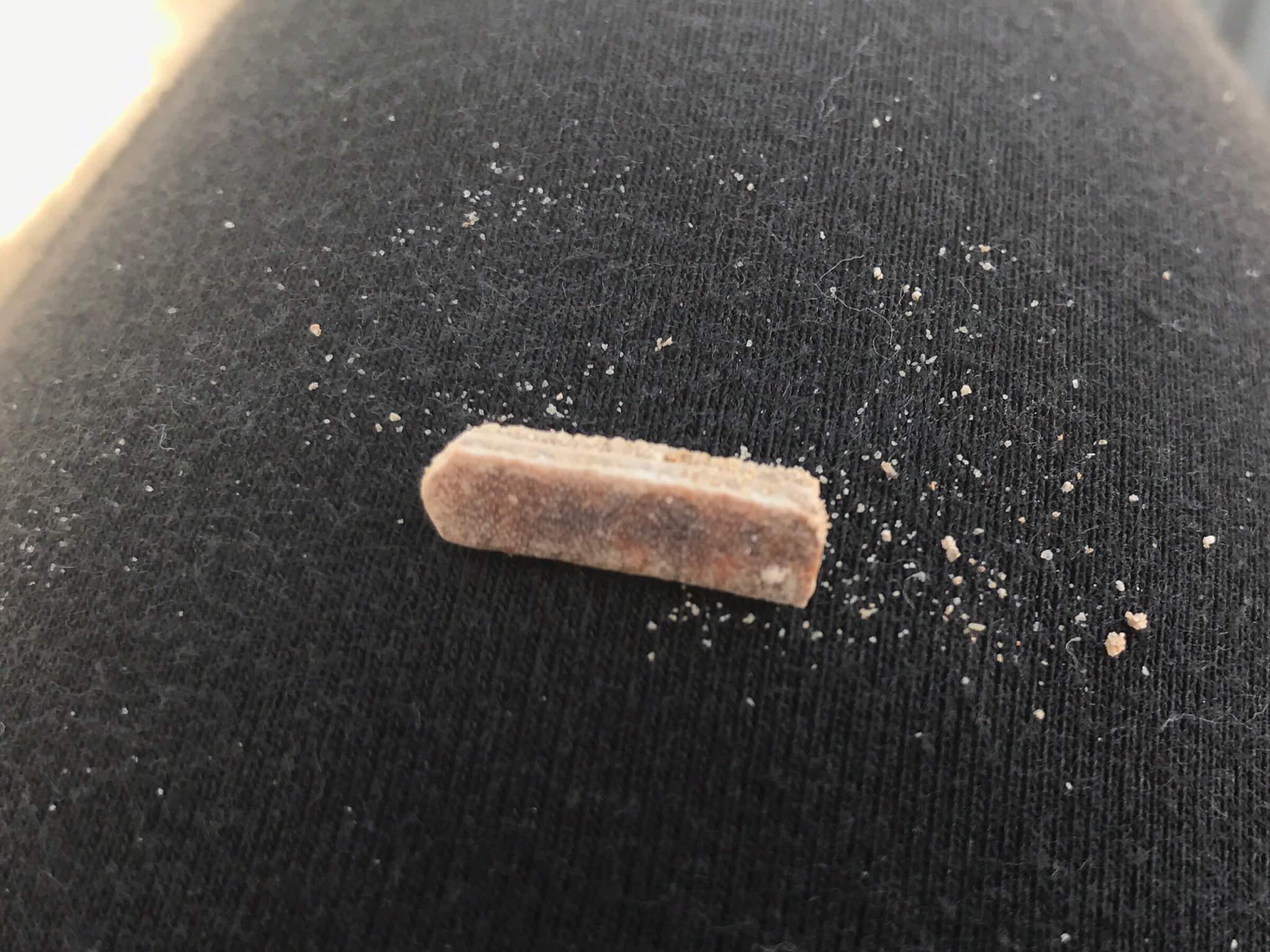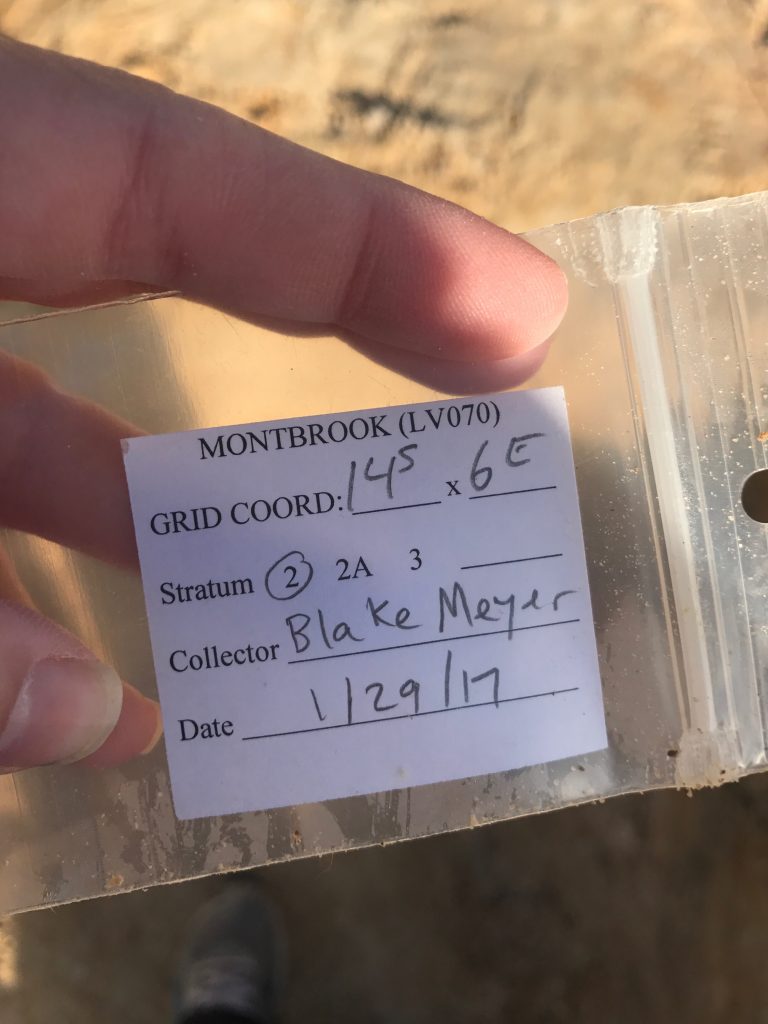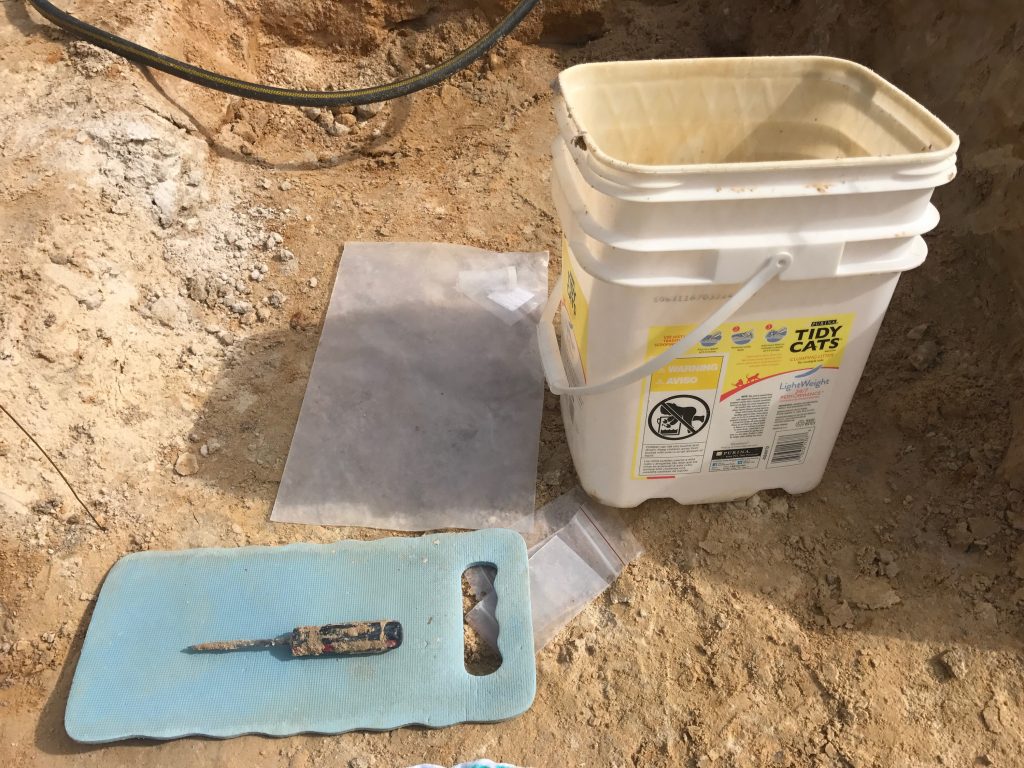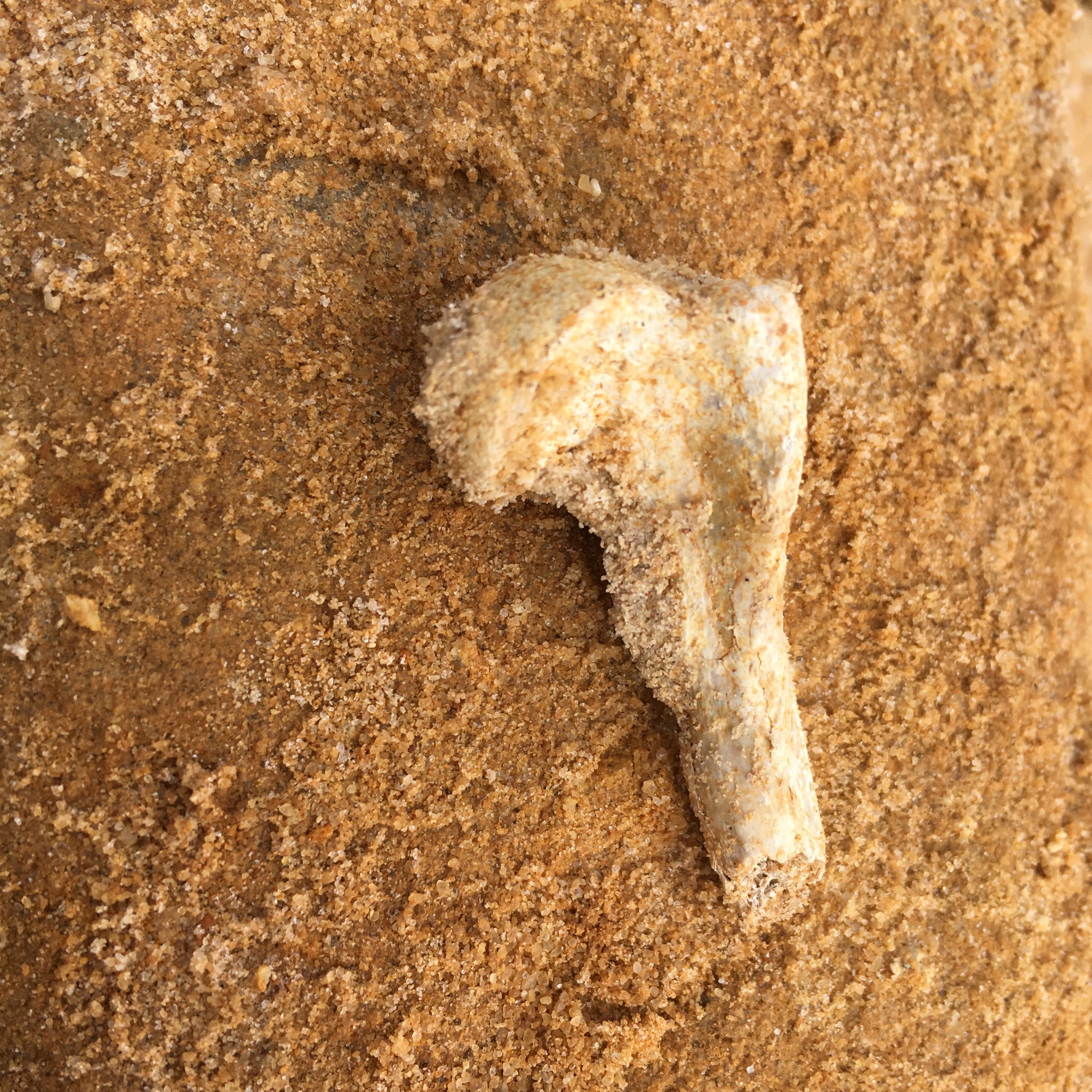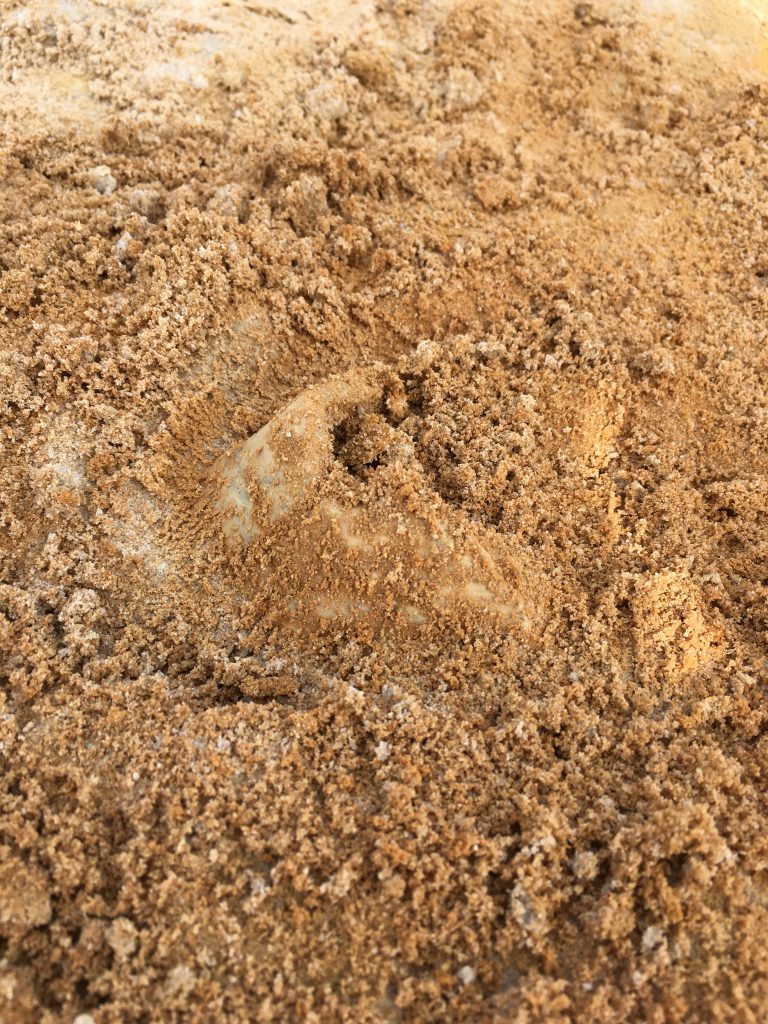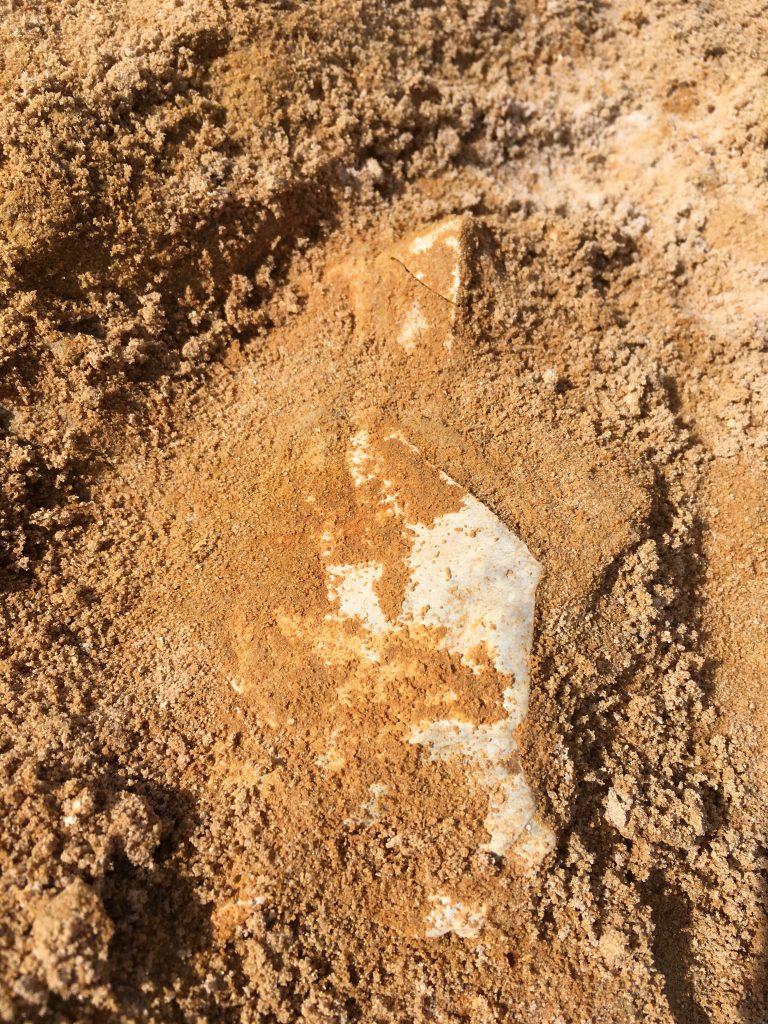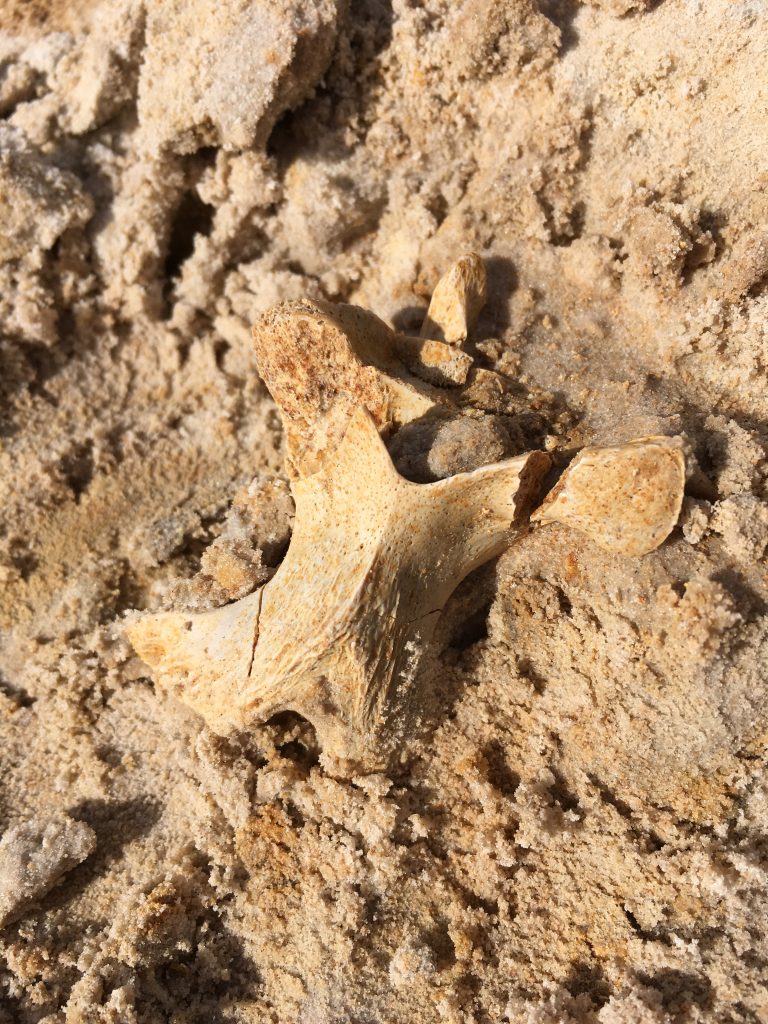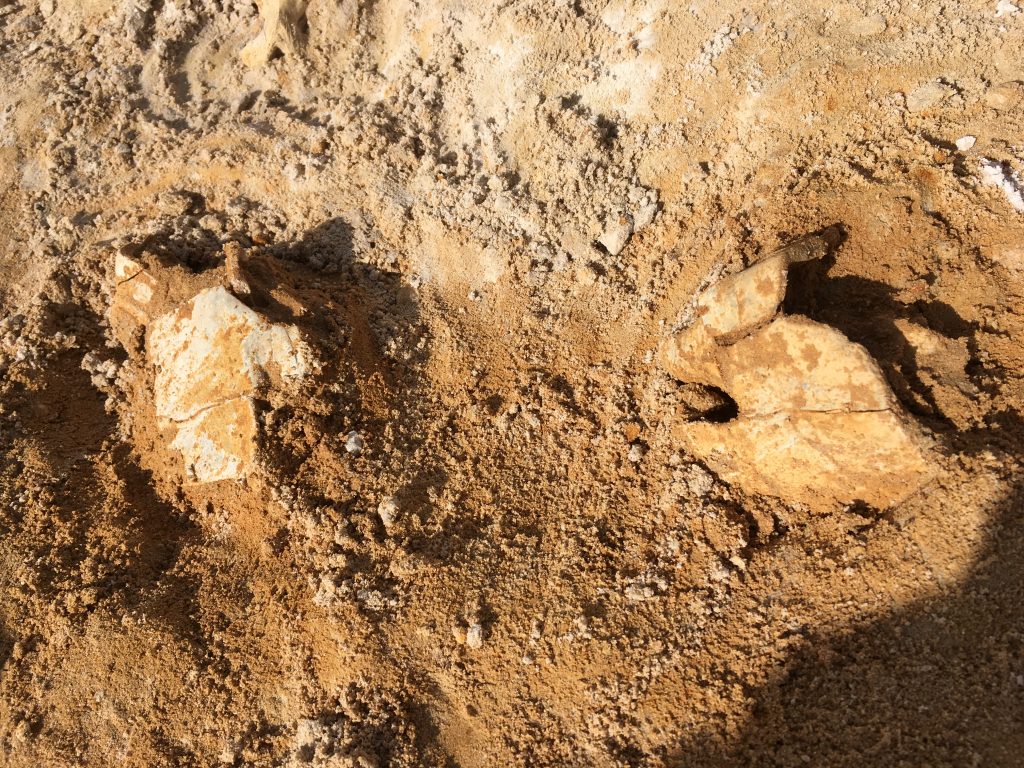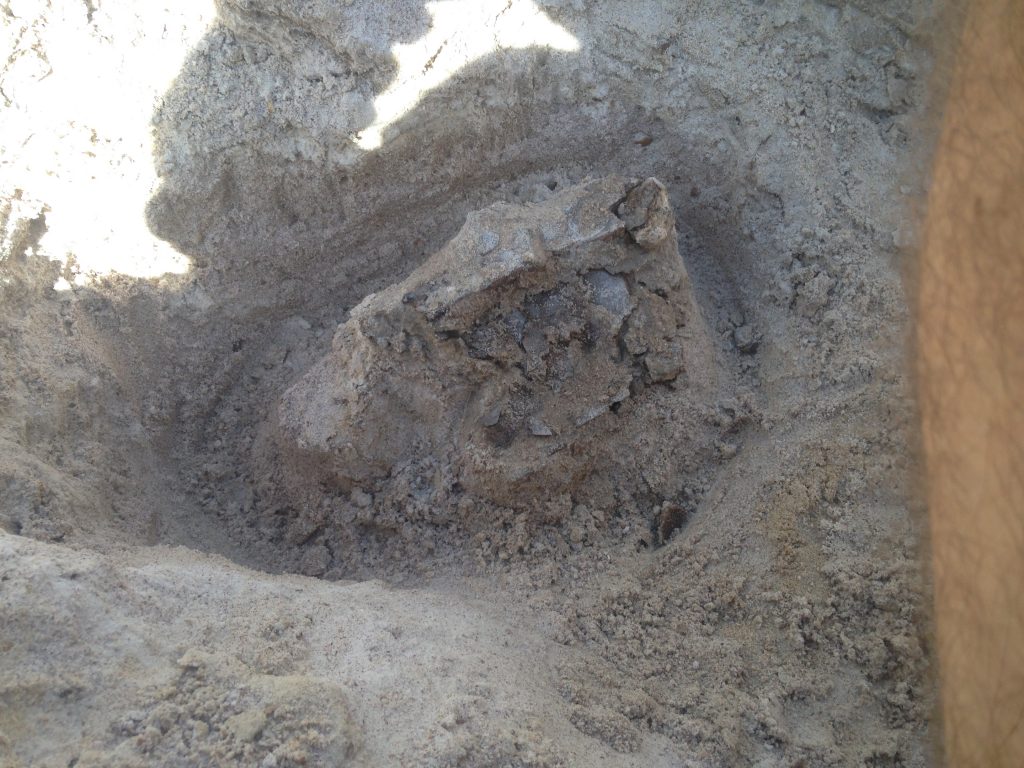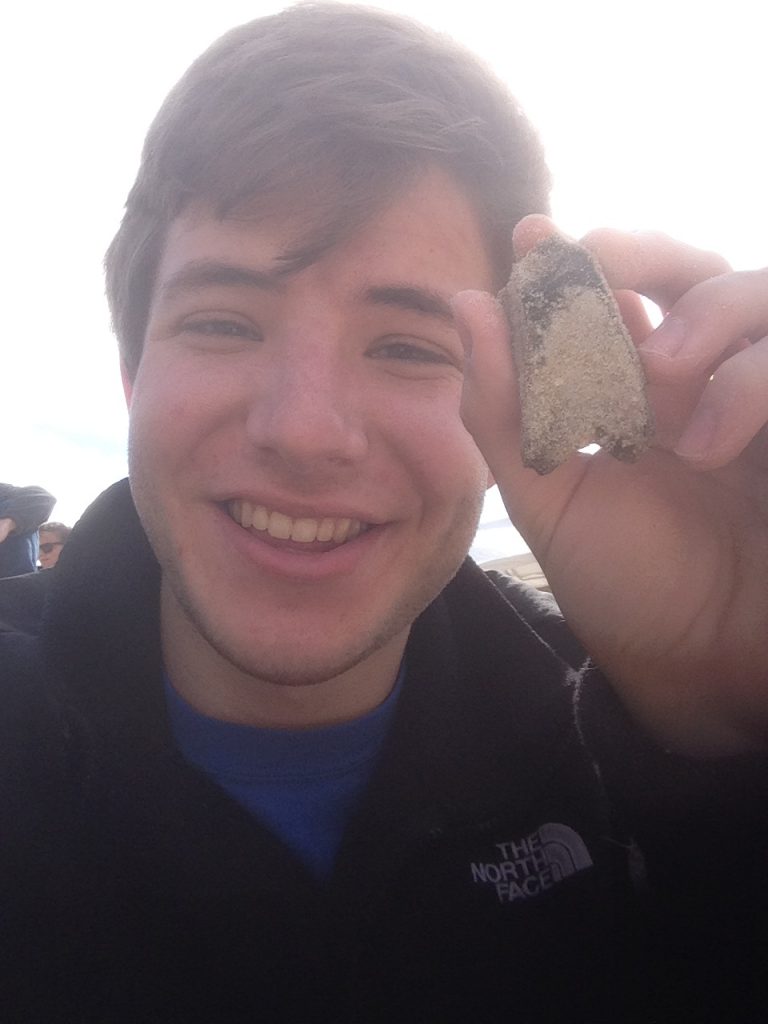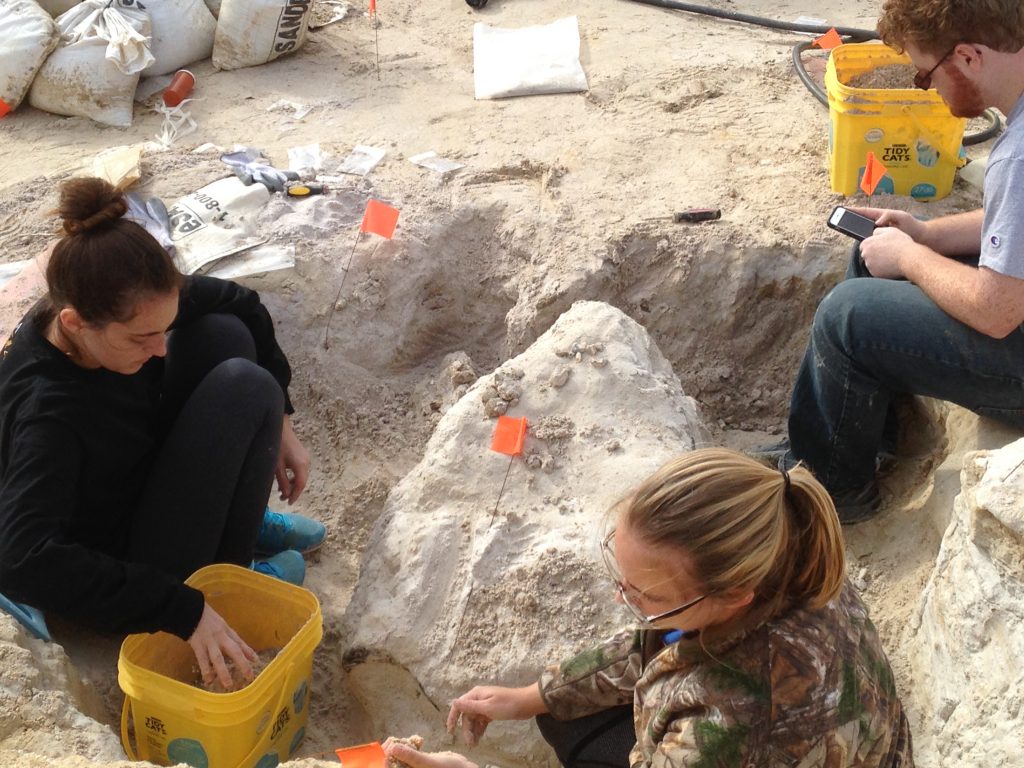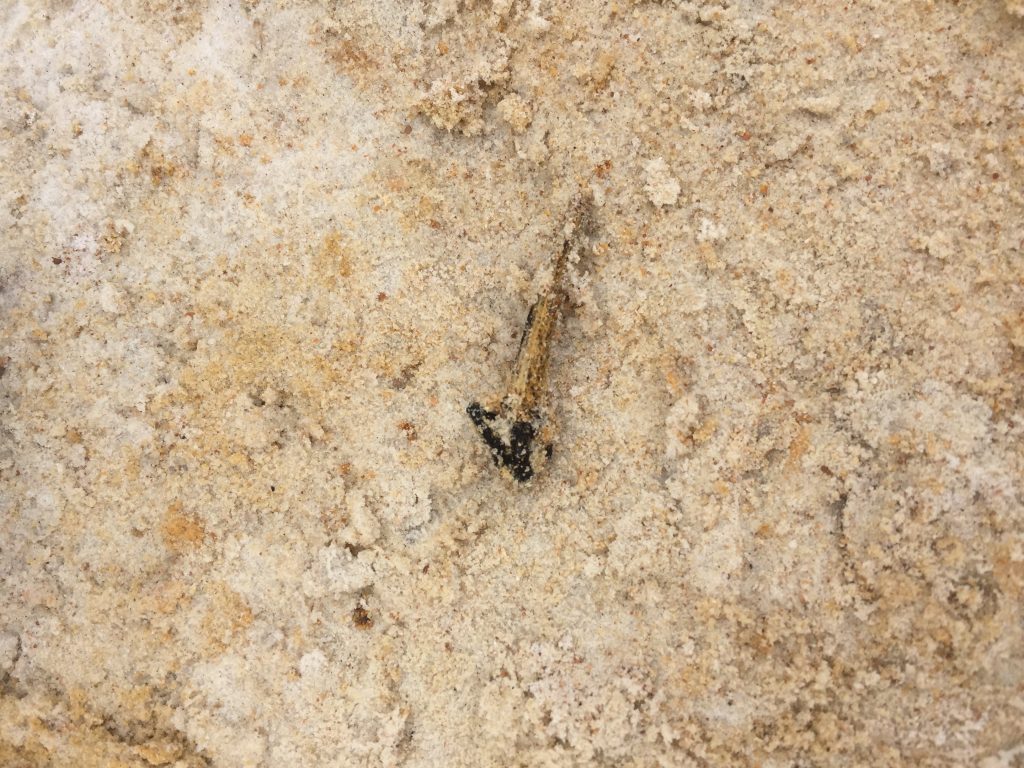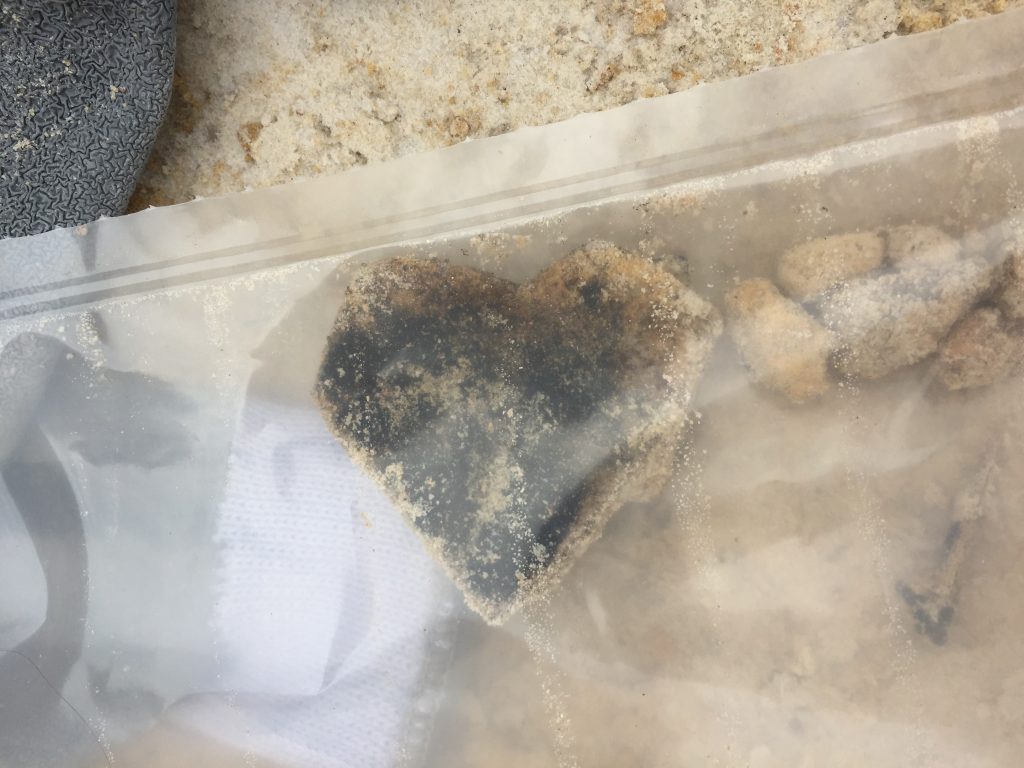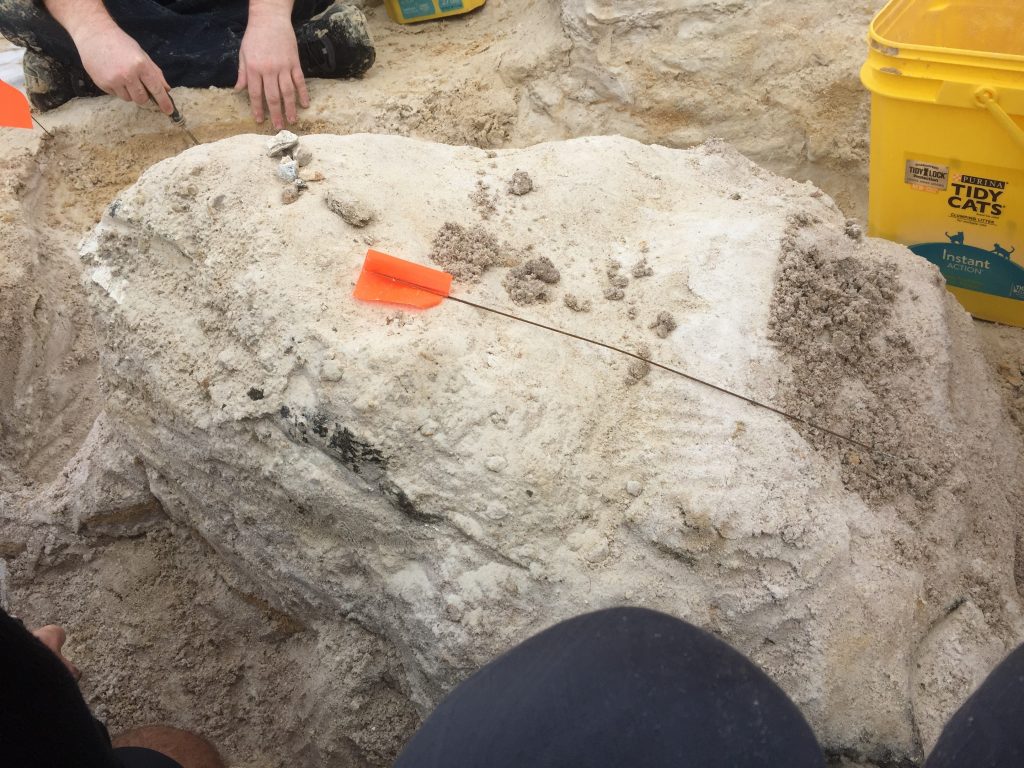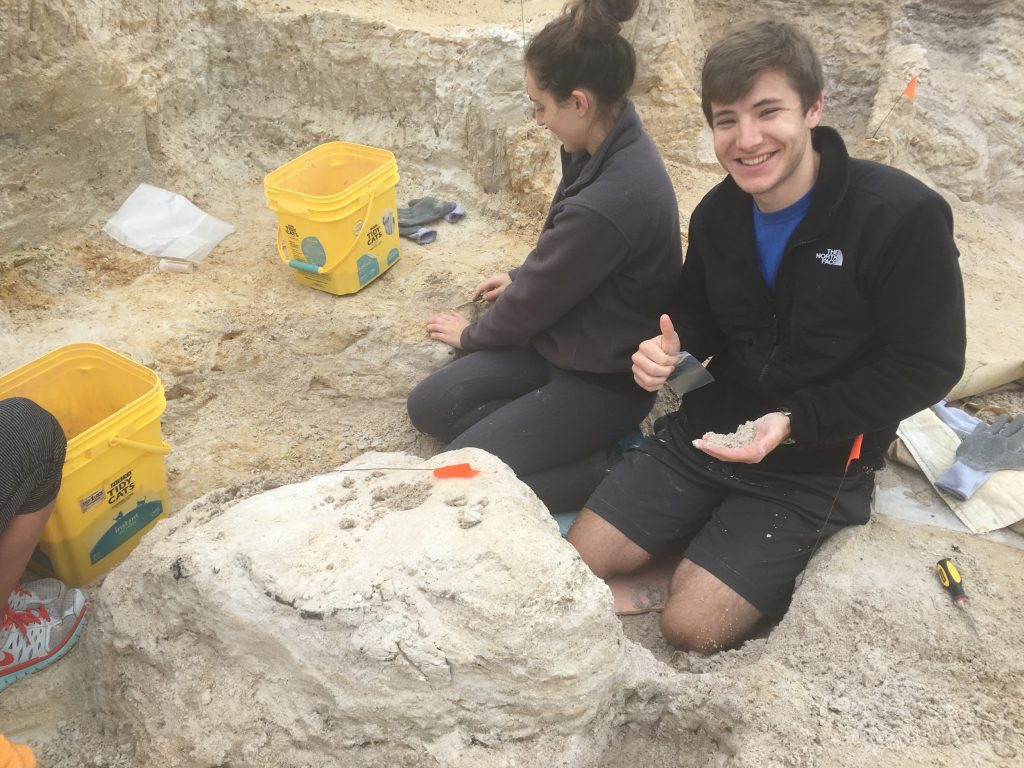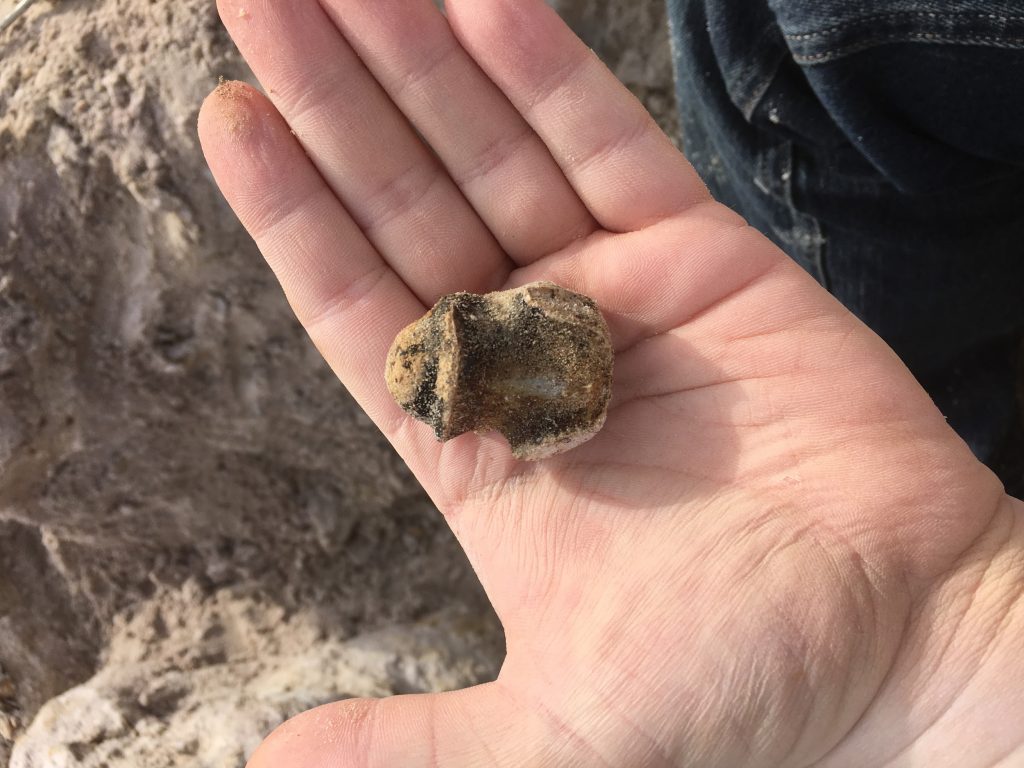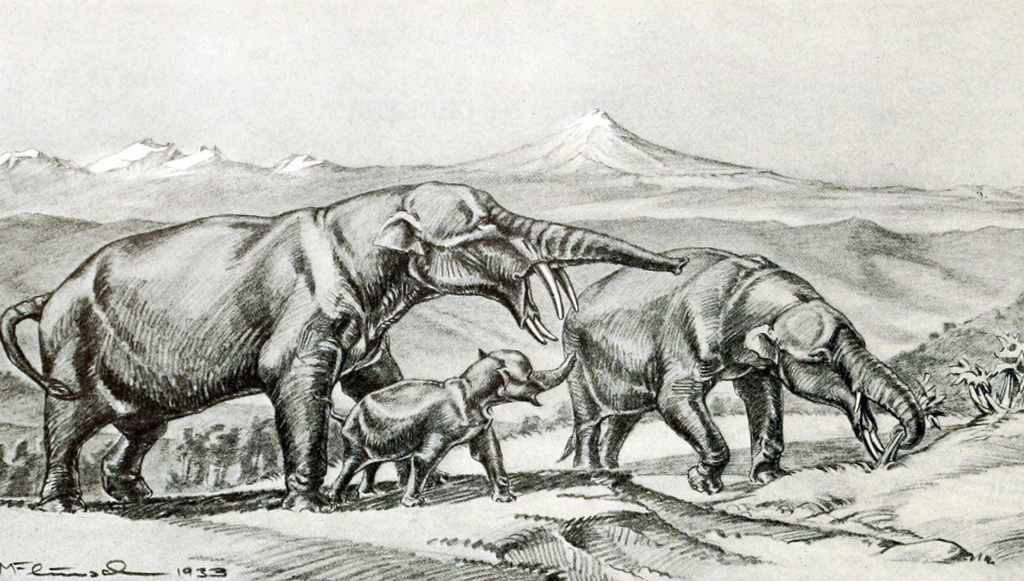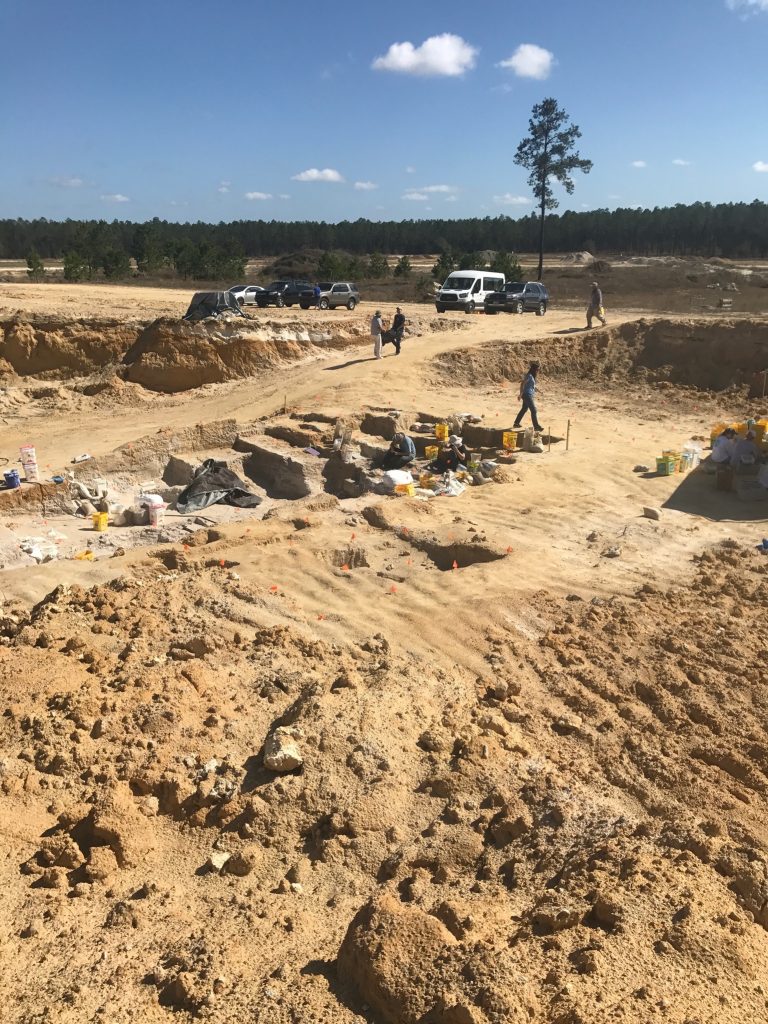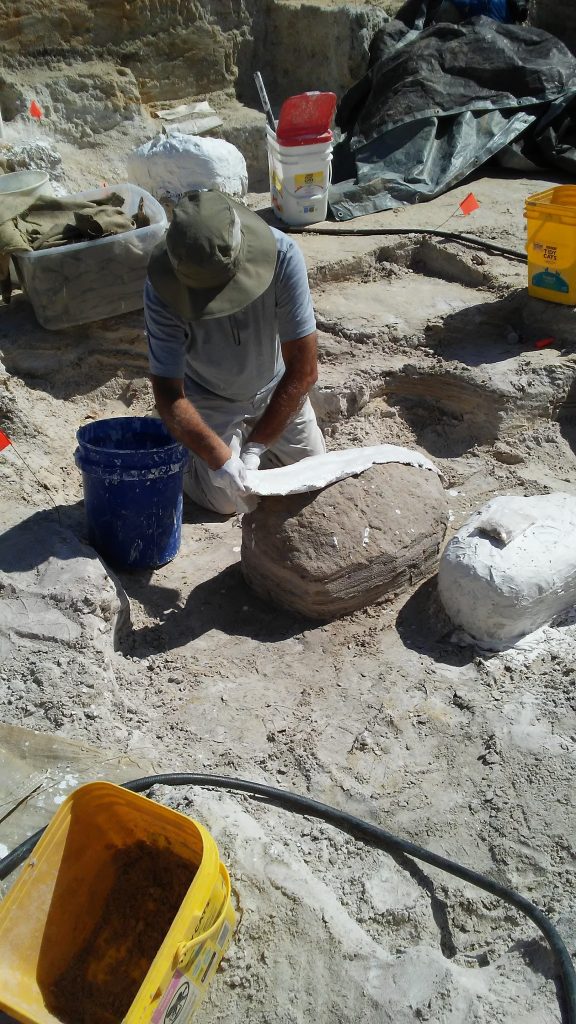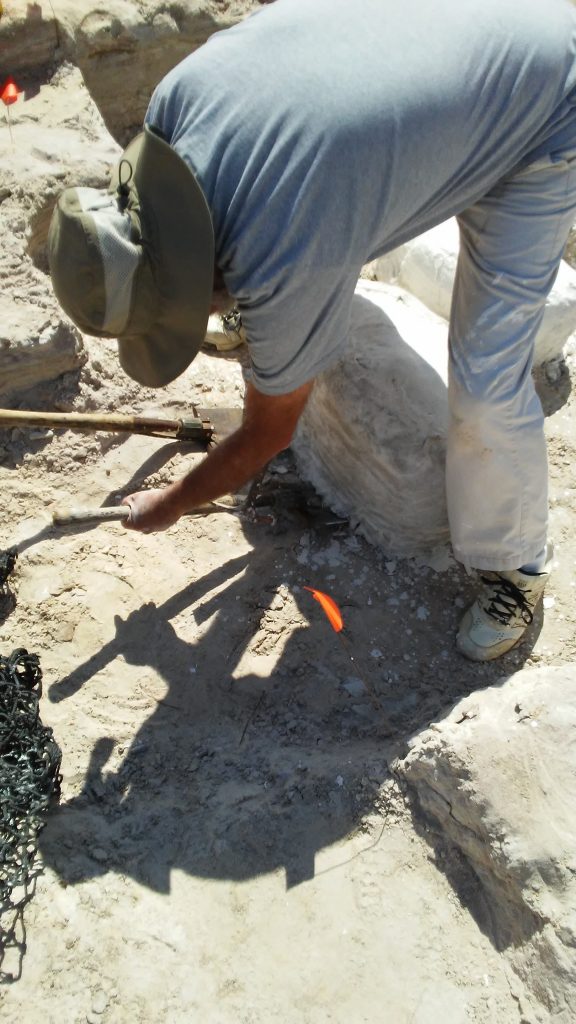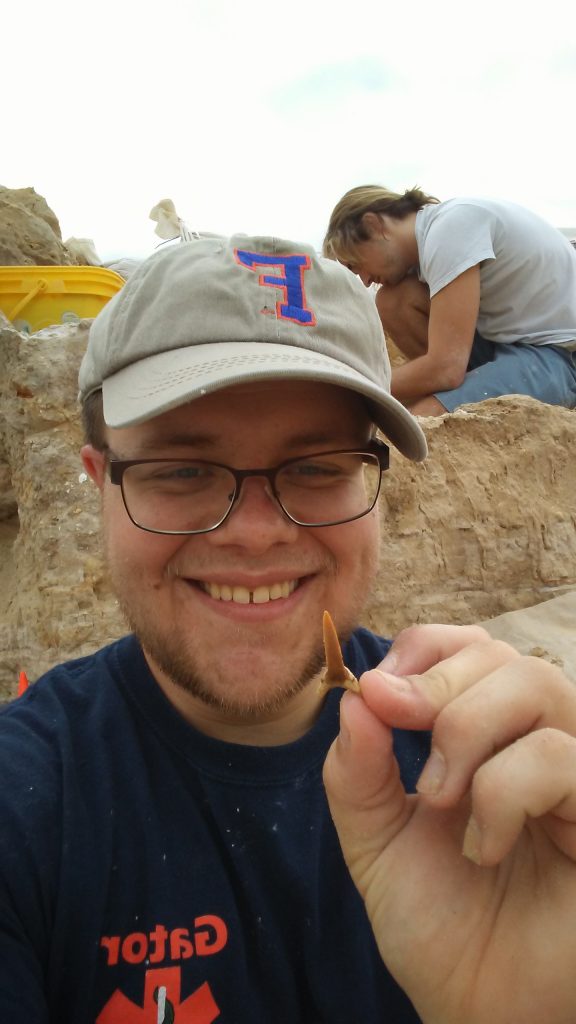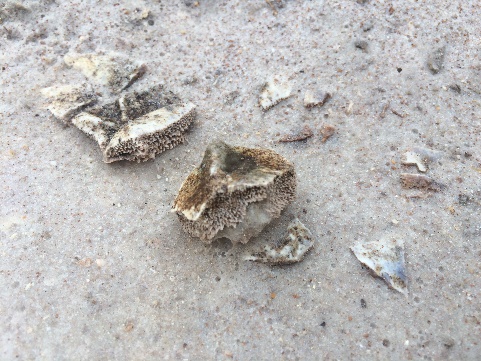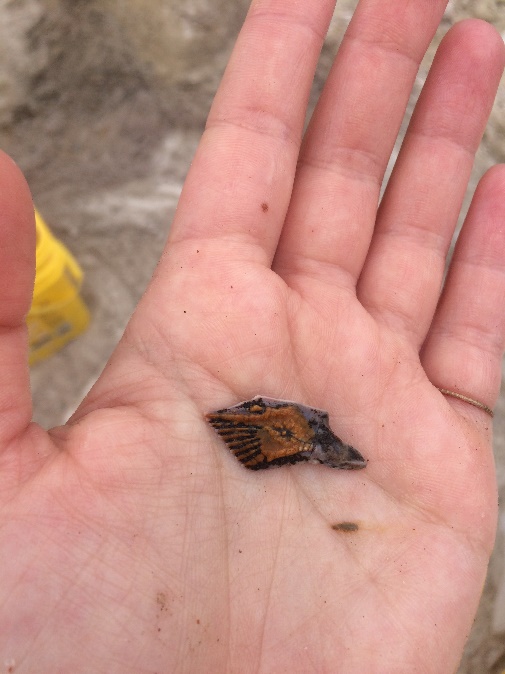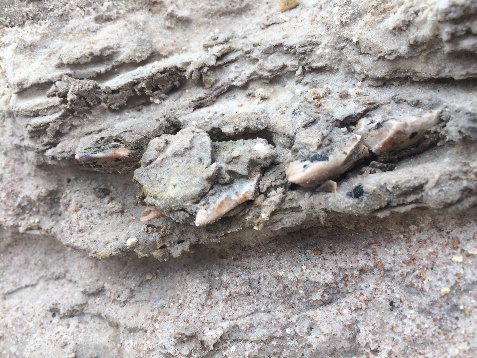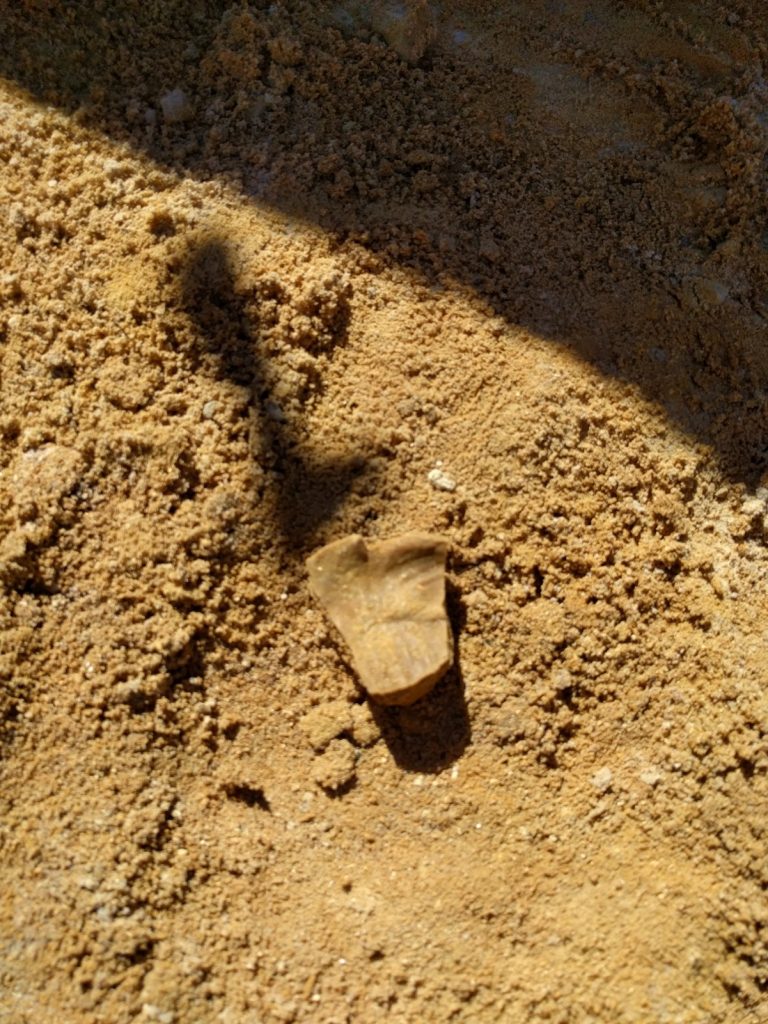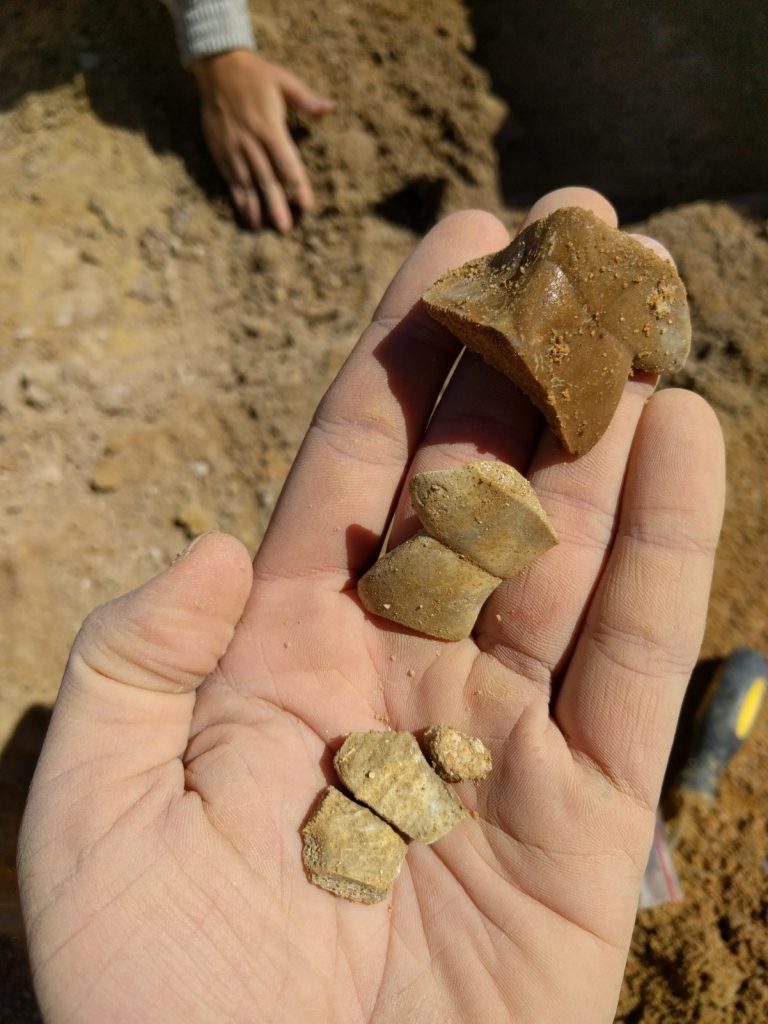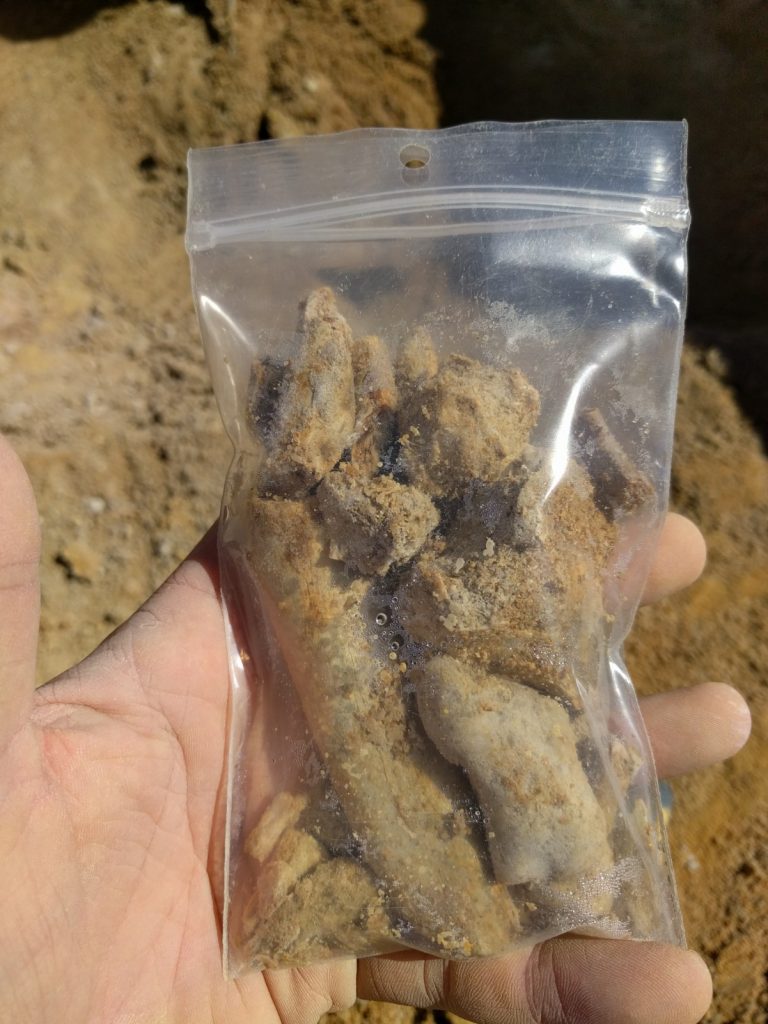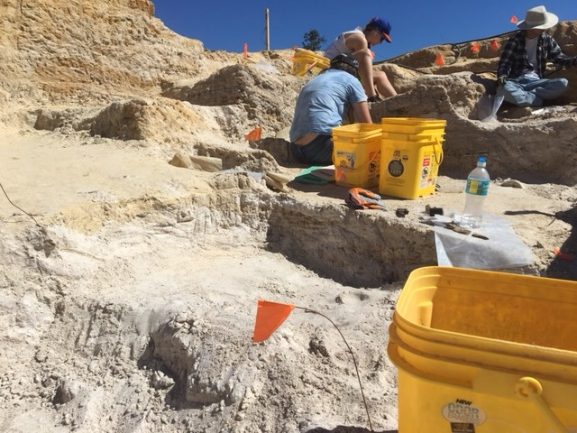University of Florida students enrolled in the Florida Vertebrate Paleontology course, visited the Montbrook site for the first time on Sunday, January 29th.
Here are some of their first impressions of digging at the site:
“My first dig at the Montbrook site was far from what I expected. I assumed it would be like something out a movie such as Revenge of the Mummy or the beginning scenes of Jurassic Park. It wasn’t like that, though; it was better.
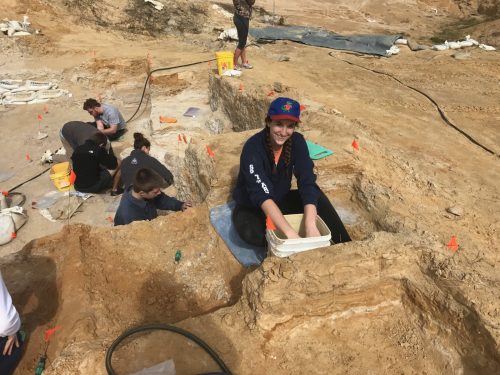
“The site was a lot smaller than I expected, at first glance looking only like a random hole in the ground. I had heard in class of all of the fossils that had been found, including old world alligators and elephants, leading me to believe that the site must be huge if it could harbor so many animals.
“But this hole in the ground, though it was small, contained so much history. Being in the small area created a perfect learning environment. There were 20 or so of us there and whenever someone found something interesting, they could easily share it with the group. I personally didn’t find any fossils in my grid coordinate, but I was able to see so much still because of the intimate setting. I really enjoyed my time at Montbrook and am excited to see what I can find next time!” – Nicole Welton

“Going into my first dig, my only knowledge about searching for fossils was from the Jurassic Park films. I knew, and frankly still know, very little about fossils. However, after my recent experience at the Montbrook site, I feel as though I now have a better understanding of fossil digging than the average person.
“At the site, I was assigned to a square meter block located in one of the uppermost layers of the site. This meant I still needed to clear a lot of sand and clay before getting to the good stuff. Nonetheless, I trudged on and eventually started to find my first ever fossils! My collection was fairly small compared to others, but again, that was due to my location. Some of my finds included pieces of a juvenile turtle shell, alligator snapping turtle bones, and a cow nose ray tooth!
“One surprising thing that I learned from my dig was that paint brushes are actually not used as much as the movies make it seem. Instead, small screwdrivers, dental picks, and bare fingers are the tools of choice. Paint brushes tend to just fill with sticky clay, and then start to break down bones. So, they are actually just a small, supplemental tool. Some other things that really surprised me about the site were the depth of the pit and the serenity of the location. Pictures just do not do the site justice in displaying how deep we are digging, and they definitely do not display how quiet the site is. Located pretty much in the middle of isolation, the fossil site space is calmingly quiet. All you hear are trees rustling and the wind blowing. I found this aspect to be a pleasant surprise and very relaxing. Overall, the day went by faster than I could have ever imagined and I cannot wait for my next dig day.” – Blake Meyer
“Today was my first day at the dig site. After a brief site history and rundown on dig procedures, I was instructed to dig away at square 14S, 8E. As I was mostly digging in the Type 2 sediment layer (red clay near the top of the dig site), I was instructed to be a little more vigorous with my digging as apparently there are fewer bones to be found in this layer. I attempted a time lapse of my first 15 minutes of digging. During this time I found a turtle vertebra, turtle femur/humerus head, fish vertebra, various fish spines, and an unidentified long bone.
“Within the time lapse, I cleared away approximately 4 buckets of dirt. Later on, I also found a partially articulated top and bottom slider turtle shell, several other slider upper shell fragments, and an alligator snapping turtle vertebra. Piece of advice: Don’t leave walls at the edges of your square! They dry out and make it impossible to remove dirt from bone in a controlled manner!” – Erich Zellmer
“Today at the dig site was my first time and an overall wonderful experience! Having never dug for fossils before, I learned the proper techniques for excavating and was able to put the use the knowledge I gained in my previous classes from studying fossils! Right away I was assigned to help clear out an area away from a large fossil that was identified to be the scapula (shoulder blade) of an elephant. However, not long into clearing away the area, I had to redirect my attention to another fossil nearby. This fossil was smaller but was unidentified, so I was tasked with clearing out the area around it so we could figure out what it was. I was able to get a large amount of the surrounding area cleared away, but unfortunately, we are still unsure what the fossil is. However, I look forward to coming back and hopefully uncovering more of the fossil to determine what it could be.
“Moving my attention back to the elephant, I continued to help clear out the clay and dirt around it, and found many interesting fossils doing so! Below there is a picture of my with my first turtle shell that I discovered, along with the unknown fossil and the scapula we were working on. Hopefully, when I return to the site, I will get to witness a plaster jacket application, as we were unable to get to it today. I can’t wait to get back to the site in a few weeks; it was such a great experience and an overall great time!” – Charles Bisbee
“Today was my first day at the site but also my very first time digging for fossils. The day was pretty successful! For the first hour or so, I learned how to distinguish clay and rocks from bone and then was able to use the skills I learned in my fossil digging the rest of the day. I was assigned an area near a very large Gomphothere scapula and was instructed to continue digging out the area around the bone so that it could be fitted with a plaster jacket. While excavating this area, I came across an alligator tooth, a catfish spine, and the edge of a turtle shell. For the other bones I collected, I wasn’t able to pinpoint what part of the body or what species they were but I hope to learn more as the semester goes on. I have included some pictures of my finds below! Overall the site was smaller than I expected and I was surprised at the amount of progress that had already been made. I am excited to return on February 12th!” – Monica Sciturro
“This actually isn’t my first time digging at this fossil site, but I’m still fairly new at it. I ended up getting assigned a spot where some gomphothere bones were in the process of being unearthed, but my job for the day was to dig down in the surrounding dirt, to get its level lower than the bones for a plaster jacket and (of course) see if there were any other fossils in the area in the process. I ended up finding several bones, especially near the beginning, but no new gomphothere fossils – mine were all from turtles or fish.

“As it turns out, I’m still learning how to tell the difference between pieces of bone (like the one above) and ordinary rocks. I’ve gotten better than I was in my first week (I think I must have asked about nearly everything then), but it can be hard – especially when everything’s covered in sediment! I’ve decided to make “getting better at telling fossils apart from rocks” one of my goals for this semester, along with getting more involved in the process of taking out a bigger fossil and finding something from a sabre-tooth cat. Obviously those latter two goals will be a little more dependent on luck, but I think I’ll be able to manage the first one. Still holding out for that cat though!
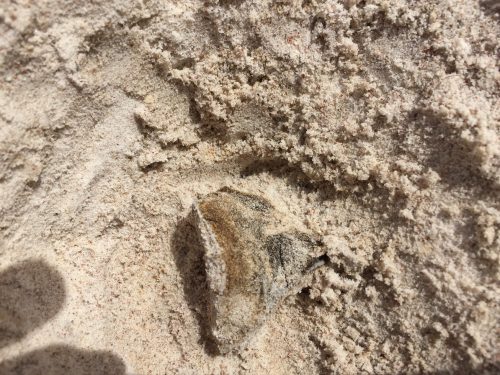
“There were a couple times where I started digging up something interesting-looking and got excited, but as the first paragraph has already spoiled, they didn’t turn out to be anything “spectacular.” This here was one of those finds – it may not have been from a gomphothere or a cat, but it was still a pretty nice-sized chunk of turtle bone. I was pleased.

“These guys were all found right near the end of the day. They have such pretty colors and patterns! They were all pretty much covered in clay, and between that and the patterns (which I’d never seen on a fossil before) I was really confused at first and thought they might be pieces of hardened clay or something. Turns out they’re all parts of a fish! That one might have been my favorite find of the day, haha.” – Cassie Schuchart
“Today was my first day on the dig site, and I managed to get in on excavating the scapula (shoulder blade) of a member of the Gomphothere family. These are four-tusked relatives of modern elephants that would have grazed all across the Americas.
“There were so many fossils in the area that we had to be careful digging around the scapula. Every few inches down into the sand and clay you could stumble across something new, like a vertebra from an alligator (middle right). The most common finds were catfish spines and gar scales, but fragments of turtle shells weren’t unusual. Excavating the scapula took the entire day, but the constant stream of bonus prizes kept things interesting.
“At the bottom is an artist’s interpretation of Rhynchotherium, the genus of Gomphothere that is associated with the site. It’s likely the original owner of our shoulder blade was one of these critters. On the top right is an image of our scapula, surrounded by our dig team. It should give an idea of the full size of the animal – it was probably one of the largest herbivores grazing along this ancient riverbank.” – Ben Rumsey
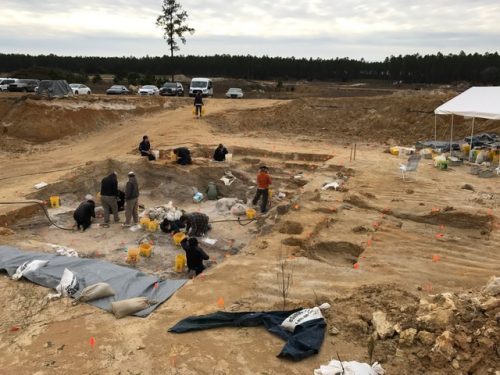
“The drive from Gainesville to the dig site was beautiful. I always appreciate driving past acres and acres of green pasture dotted with grazing cows and sleepy calves. Nearing the site, I drove through rows of planted pines to an area that had been cleared by heavy equipment. On first impression, the dig site was rather unimpressive, however, upon a trip uphill, I turned around to see all the tarps removed with the volunteers in their place and it all started to come together like I had pictured.
“Of course, my experience with archaeologic dig sites is limited. More specifically limited to Jurassic Park, 1993, where they uncover a fully intact velociraptor skeleton and Dr. Grant imitates gutting the kid like a raptor would to put him in his place. Anyway, on the day of our first dig, myself and three others were tasked with digging around the scapula of a Gomphothere in order to make room for a plaster jacket. I was amazed that they could identify it as a scapula since, to me at least, it looked like a big lump of sand with a few inches of dark colored rock exposed. The ground was softer than I expected and sifting through the sandy-clay was relatively easy. We spent the morning digging several inches down around the scapula, collecting small fossils along the way.
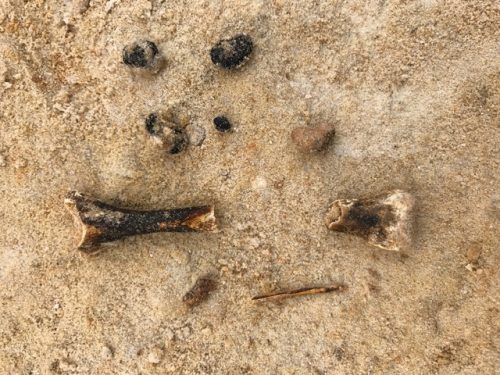
“Come lunchtime I started to get discouraged, especially since the fossils I meticulously excavated that morning turned out to be three small rocks, a dark piece of clay, and a compacted lump of sand. After lunch, my classmates around me continued to find fossils, including an intact alligator tooth, parts of a turtle shell, and several catfish spines. Late afternoon, I caught my big scientific break: a turtle leg bone! It was dwarfed in size compared to the scapula it was found by, and I continued to look for more parts but to no avail. Could I use this bone to frighten a kid about the cunningness and ferocity of a 5-million-year old turtle? Probably not, but I was really proud and excited to find it so I took a little extra time to study and appreciate it before bagging it up.
“By late afternoon, it was quitting time. We had made good progress digging around the Gomphothere scapula and it would be ready for a plaster jacket in the next day or so. I’m excited for my next digging opportunity in a few weeks to see what other fossils have been uncovered and how the dig site has changed.” – Storm Wittenberg
Sunday, February 12
“Today was my first day at the site. Going into today, I did not know what to expect. Once at the site I had the opportunity to make a plaster jacket. I learned quickly how fast plaster dries after having my hands and hair encased in plaster.
“After that I got to dig, while I did not uncover anything as big as I wanted I found many cool fossils such as alligator vertebrae, drum spines, turtle shells and gar spines. Overall it was a fun day.” – Billy Annis
“I didn’t really know what exactly to expect for my first paleontology fossil dig. The one thing I knew for certain though, was that I really wanted to find a shark tooth. After getting to the site and given some instruction it was time to start digging. The first thing I pull out of the ground thinking it might have been a fossil turned out to be a small rock. The next thing I pull out thinking it might have been fossil turned out to be… a different type of rock. Everyone around me though seemed to be finding really awesome stuff so I continued searching for that shark tooth. After that I didn’t seem to find much of anything for a couple hours. Then Richard, a paleontologist, asked me to help him make a plaster casing of this massive elephant vertebrae in order to remove it from the site without damaging it. I wasn’t going into this completely blind as I saw someone else make one earlier so I jumped right in. Once finished, me and Richard were basically covered in plaster but the experience was definitely worth it. After cleaning up a bit I got back to digging in a different area of the site. Within seemingly a few minutes I had finally found this really awesome shark tooth. This made every second of digging worthwhile. I had dug up my first fossil. After a couple more hours of seemingly finding one fossil after another it was time to clean up and go. It took some time for me to find my fossil but the whole experience was definitely a wonderful time. I am really excited for my next dig.” – Justin Farley
“It was not so bright and early when I arrived at Dickinson Hall for my first dig with the class. I didn’t know what to expect but I was excited and hopeful – some of the girls waiting outside for the class van to arrive told me about the bones they had been finding. When we pulled into the dig site it was already some meters deep and was scattered with the casts of large fossils found in the days prior. I learned that one of them was from a large elephant-like creature and although I didn’t find anything exciting in my square on that day, sitting next to something like that was amazing and sparked so many thoughts. How did it die? What did it look like? This mostly characterized my first day of digging – a lot of day dreaming about the animals that roamed long before I existed.” – Estefania Melo
Wednesday, February 15
“Vacation for class credit? Given my high-stress busy schedule of work and classes, I was looking forward to my first day of digging at the Montbrook fossil dig site. I had a preconceived idea of how the day would go. Drive out to a desert and dig all day for the opportunity to find that one shark tooth that may or may not be within your digging section. Regardless, it would be a nice day of digging and relaxation from my hectic norm. On the drive over to the site, I was already filled with joy. The views and the land that lead up to the digging site were all beautiful. The site wasn’t the barren land I envisioned, it was actually surrounded by beautiful trees right before entering the actual digging location. When I first stepped out of my car, I was at peace. It was absolutely beautiful everywhere I looked. When I joined the digging team, I received a short and precise instructional guide to digging, and then I was off with a square of my own to dig up. Almost instantly I found a fossil! I couldn’t believe it and brushed it off to beginner’s luck.
“As the day progressed, I became so absorbed in my digging that I didn’t even remember to eat my lunch. Not only was my bag of fossils filled, but I had discovered what was believed to be a fully intact turtle shell. I was told that we would need to make a plaster jacket in order to retrieve my shell from the ground but was instructed to dig out the full perimeter of the shell. Never could I have imagined to discover a full skeleton, it was so thrilling. Yet, probably the most thrilling part was that I wasn’t alone. At the Montbrook site it felt like everyone around me were also uncovering marvelous and full fossils. This site blew away all my expectations for fossil digging sites. I had the realization that we are all in the midst of scientific discoveries and I am able to discover full and extremely relevant fossils. When the day passed and I was forced to go back home, I had the most incredible drive back. As soon as I pulled out of the site, I was surrounded with wild cows crossing the road. I drove down the road slowly with the biggest grin on my face. I had just had the most incredible earthly experience. Between uncovering the beautiful history in the sand below my feet, to absorbing the beautiful environment, and then finally enjoying the company of the animals around me, this was the best vacation I could have asked for. I cannot wait to go back and am so excited to see what I will uncover next!” – Kelsea Rose
Sunday, February 26
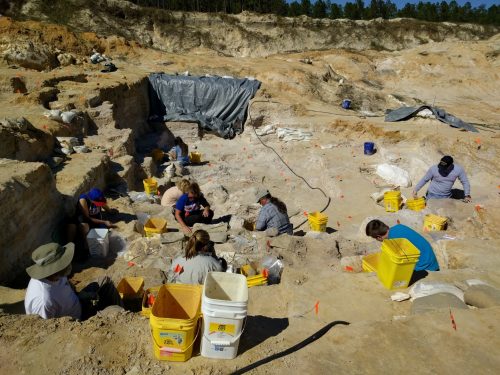
“February 26th was my first trek out to the Montbrook fossil site. I rode my bike to the site and it was an overall pleasant ride – albeit a bit scary at the end passing through the herd of cows as I approached the dig site!
“I arrived to some volunteers already in the pit working and Dr. Richard Hulbert happy to give me some background. He explained this site’s main purpose, mining ancient windblown dunes of pure, white sand. Our interest is below that layer according to him, and looking into the pit it is quite apparent. Large bones are partially exposed in the middle of the pit in the deeper areas. Around that largest bone group, volunteers work in 1×1 meter squares.
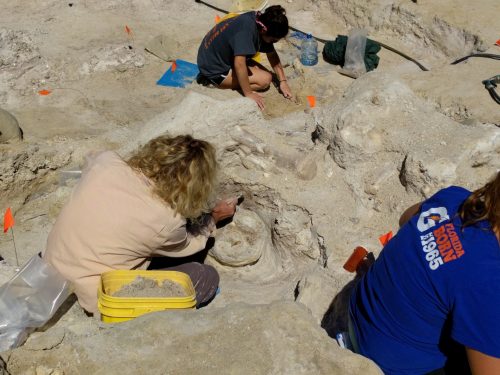
“I am given what are apparently the essentials – a screwdriver, a slab of foam, and an empty kitty litter bucket (as well as bags to hold any fossils I would find).
“I am assigned a square and told to work my way down using the screwdriver. The sediment I worked in was a bit moist which helped make my digging a bit easier. It was not long before I found my first fossil, a carapace scute from a turtle.
“The next few pieces would also be carapace scutes!
“Later as I dug my square deeper, I found a partial alligator leg bone.”
“The rest of my day yielded only fragments and I seemed to have the best luck during the beginning of my dig.
“As the day wore on and the bike ride home loomed in my head I packed up and headed out. Overall the experience was extremely rewarding. I have never seen or participated in a dig that was so fossil-rich. Everyone had their hands on something. I can’t wait to head back and see what my dig turns up. Anyone thinking of volunteering – don’t forget plenty of water and some sunscreen!” – Nicholas Herrera
Sunday, March 19th
“After being assigned my little square the first day, I began chipping away at the dirt, having no clue of what I was doing. I strained my eyes studying pebbles and made very, very slow progress- feeling very little connection to the dusty spot I was given. Feeling discouraged as others unearthed cool teeth and claws, squealing with excitement, I searched out some advice on my digging techniques. With my new technique, it took about thirty minutes before I transformed into a focused, territorial mad woman. Suddenly I took pride in my tiny little square as carefully moved down an inch or so at a time. I felt like an old lady chained to a slot machine in the final years of her life. I thought, “A big find is just around the corner. Keep going, Alex!” I was mesmerized by the smooth, intricate designs in my first gar scale. I thought I unearthed a treasure, then they kept coming and coming, but none as pretty as my first gar scale. I ended up finding several turtle shell pieces that miraculously fit together, even though they were found a significant distance apart in my mind, and some very cool vertebrae and jawbones. Although I did not unearth a paleontological marvel, I left the site feeling fulfilled. I cannot complain- blue skies, a breeze and sunshine! It was a great first day and I can’t wait to return.” – Alexandra Campione
